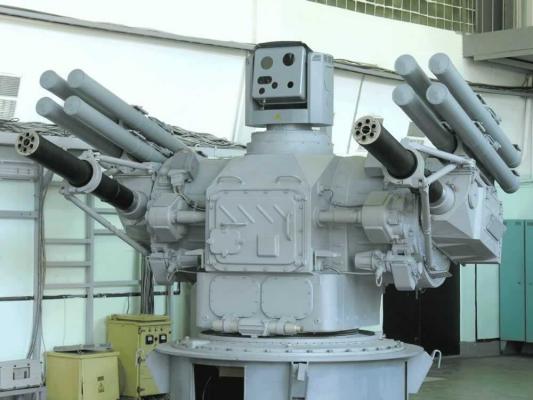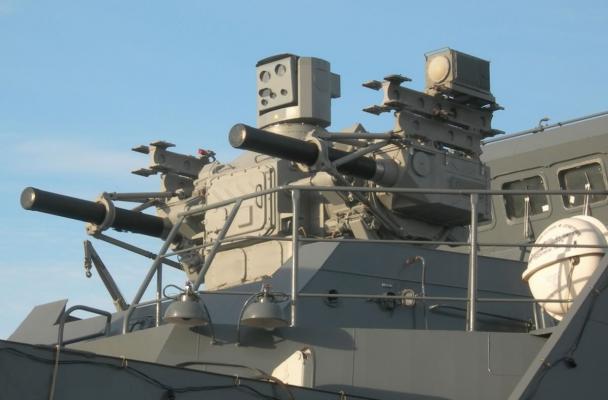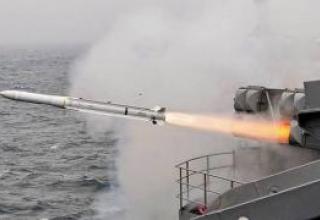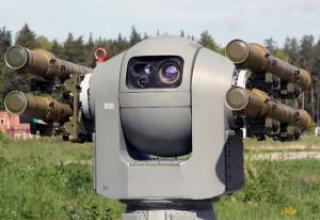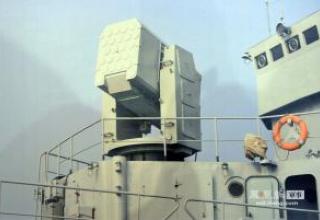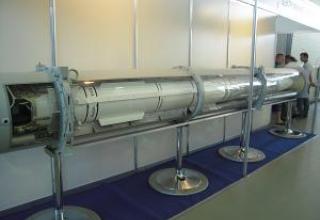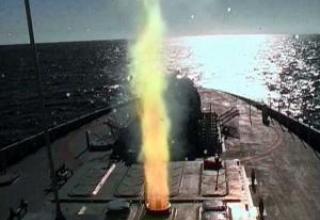Marine anti-aircraft missile and artillery system "Palma" ("Palash") is designed to create a continuous echelonized system of air defense of surface ships with a displacement of more than 500 tons at a range of 10 km.
The complex provides defeat of aircraft and helicopters of tactical aviation, unmanned aerial vehicles, cruise missiles and other types of high-precision weapons around the clock in all weather conditions at a range of up to 10 km.
The development of the complex was carried out at JSC "Design Bureau of Precision Engineering named after A.E. Nudelman", which is part of the holding company JSC "NPO High Precision Complexes", in close cooperation with the State Unitary Enterprise "KBP", JSC "AK Tulamashzavod", JSC "KB Amethyst" and other leading enterprises of Russia.
The development of the first variants of the complex under the designation of "Palash" for the Russian Navy has been carried out by the Nudelman KBTM since the 90s of last century. The complex was developed as a replacement for ZRAK "Kortik". Range tests of ZRAK "Palash" were conducted at Feodosiya range (object 30, Crimea). After their completion in autumn 2005, a prototype combat module, designated A-289 (see photo), was transported to the SRZ № 13 in Sevastopol and installed on the missile boat R-60 project 1241. In December 2007, the Palash ZRAK was adopted by the Russian Navy for pilot operation. The second instance of the complex is mounted on the missile ship "Dagestan". of the Caspian Flotilla.
The Palash SAM system is part of the armament of promising Russian Navy ships, including Project 20380 corvettes and Project 22350 frigates.
The export version of the complex - "Palma" is installed on patrol ships on the Ave. "Cheetah Ave. 3.9" built for the Vietnamese Navy at Zelenodolsk Shipyard named after Maxim Gorky (see photo_1, photo_2). Tests of the complex under field conditions on the ship at the Ave. "Cheetah 3.9" confirmed the high accuracy of guidance - all the presented targets were hit by the first rocket or the first queue (see photo).
The modular design of the complex ensures the possibility of using it on ships of various types, including those on the ships called up and ashore. In these cases, the container version implies the introduction of a radar detection station and gyrostabilization system into the basic equipment.
ZRAK "Palma" has a large modernization potential and is fully unified with the ground complex "Sosna-R" in terms of the main structural elements - defeat and control means.
Composition:
The armament of the Palash ZRAK firing module includes two high-speed modernized six-barreled 30 mm automatic guns AO-18KD and small-size ZUR 9M340E "Sosna-R". Armament, target tracking and pointing devices are placed directly on the artillery unit on "one axis" to eliminate errors caused by deformations of the ship.
The AO-18KD (GS-6-30KD) guns with a total firing rate of 10,000 rounds per minute have a range of 200 to 4,000 metres and a kill zone of up to 3,000 metres. Two types of projectiles are used as ammunition: fragmentation and blast rounds (initial velocity up to 940 m/s) and armor-piercing sub-caliber rounds with heavy tungsten-nickel-iron cores (initial velocity up to 1100 m/s). The reaction time of the artillery unit is 5-7 seconds. A set of automatic rifles - up to 1500 shells. Ammunition feed mechanism - plateless auger. The gun has a low technical dispersion, which allows to hit even such an extremely heavy target as an anti-ship missile.
ZUR 9M340E "Sosna-R" includes a marching stage (projectile), a detachable engine and an unlocking unit (see diagram). The launch vehicle has a short acceleration time and is characterized by high aeroballistic perfection. For guidance of the missile a combined control system is used - a radio command system at the initial section of the trajectory and a high-precision interference-proof laser beam after separation of the engine and output of the missile on the sighting line. The efficiency of the 9M340E combat application is ensured due to the large transverse accelerations placed by the missile and the use of special control algorithms implemented in the microcomputer on board the missile. The maximum available transverse overload is 40g.
Battle unit: shrapnel-rod for hitting on the span, armor-piercing shrapnel for hitting in direct hits. The BC is equipped with a non-contact laser fuse with a continuous circular radiation pattern and adaptive blast time.
The 9M340E rocket is placed, stored and launched from the transport and launch container, and does not require routine inspections and maintenance during operation and storage.
Optical-electronic system (see the scheme) of the complex provides detection, automatic capture, tracking, measuring of angular coordinates and range, as well as pointing the information field of laser-beam control channel (LBC) on the target at any time of the day under the conditions of organized and natural interference, including against the background of clouds, local objects and horizon line.
The JESU is a part of it:
- optical-electronic system;
- digital computer system;
- panel operator's device;
- armament drive unit;
- power supply device.
Opto-electronic control system of "Palma" complex contains a gyrostabilized platform, which houses a thermal imaging camera, TV, laser beam channel control and laser rangefinder.
Target detection can be performed in two modes. In the first mode, detection is carried out by means of optoelectronic control system, in the second (reserve) mode, designed for operation in particularly difficult weather conditions, the complex receives target designation in an automated mode from ship radars of 5P-10 type.
The complex implements automatic, inertial and semi-automatic modes of guidance of the missile. Due to application of modern algorithms, as well as the system of information processing and decision making, which allows to exclude the necessity of operator's constant participation in the short-term processes of combat work, high automation of the complex combat work process is achieved. In semi-automatic mode, used mainly in a complex interference environment, the control is carried out by the operator.
High noise immunity of the system is provided by using narrow fields of view of information channels and the use of special algorithms of signal processing in the filling station with the use of a set of target signs, as well as the impossibility to distort the narrowly directed laser beam of the guidance of the missile or to illuminate the photoreceiver of the flying missile with a similar beam.
Characteristics:
| Palma" firing module | |
| Target range, km | 0.2-10 |
| Flight height of targets, km | up to 5 |
| Time from receiving the CC to opening fire, s | 5 |
| Weight with ammunition and secondary power supplies, t | 7.4 |
| Opto-electronic control system | |
| Range of pointing angles, deg: azimuth around the corner |
±178 between -20 and 82 |
| Maximum angular speed, deg/c | 50 |
| Maximum angular acceleration, deg/s2 | 150 |
| Field of vision, deg: television system thermal imaging channel |
2.0х3.0 /6.5х9.0 1.67х2.5 /8.0х12.0 |
| Range of target tracking at MDV=15km, p=80%, km: aircrafts helicopters cruise missiles armored facilities |
16-30 10-14 8-12 8 |
| Accuracy (SKO): stabilizations, mrad coordinate determination, mrad range finding, m LD guidelines homing LLKU, mrad |
0.07 0.2 5.0 0.1 0.08-0.12 |
| Pine Rocket. | |
| Defeat zone, km: in range: in altitude: |
10 5 |
| Flight speed, m/s: maximum pointing average |
875 565 |
| Total mass BC, kg | 6.9 |
| The mass of ZUR, m: launch at the TIC |
30.6 42 |
| Caliber, mm: before separation after separation |
132 72 |
| Length of ZUR, mm: in flight at the TIC |
2317 2400 |
Testing:
From September 1 to November 28, 1945, the Nb.W.42 trophy mortar was tested at the Red Army State Automobile and Space Administration. The tests were carried out on the basis of the order of the Deputy Chief of SAKP, Major-General of the Engineering and Artillery Service of Serebryakov under the program of the range - SAKP task №4410.
In the report No 0116 dated 19.1.46 the description of the device and operation of the Wgr.42 mine, L.J.gr.Z23nA fuse and the mortar were given. Data on the heap and range, as well as theoretical calculations of internal and external ballistics are given. In addition, the report contains the results of analysis of the hull materials and equipment. The test manager was Captain Lerner.
The purpose of the tests was to determine:
- basic characteristics of the mortar and the mine Wgr.42 /description of the device, operation and purpose/.
- Intraballistic characteristics Wgr.42 /powder gas pressure and charge burn time/.
- aerodynamic characteristics Wgr.42 (wind tunnel blowing).
- The impact and maximum mine speed and the nature of mine buildup in the active area.
- Maximum range at 10°, 20°, 30° and 45° elevation angles.
- The mine's blast and fragmentation effect on the target.
- the system's strength, stability and rate of fire.
When measuring five minutes on centering belts, the projectile caliber was 214 mm, so the report suggested "counting the caliber not 210 mm as usual, but 214 mm".
The conclusions of report No. 0116 were as follows:
- The 210 mm Wgr.42 rocket projectile with the M-13UK missile was characterized by simplicity, cheapness and availability of materials that were used for its production. It was noted that the Germans considered it possible for missile chambers to allow deformation at maximum pressure beyond the elastic limits, i.e. the chambers were calculated not on the elastic limit, but on the temporary resistance to rupture with a margin of strength of the order n=1.5.
- Manufacturing of dinitroglycol powders for rocket charges had advantage in comparison with manufacturing of nitroglycerine powders. As glycol was based on cheap raw material base (vegetable oils), and glycerin was mainly produced from animal fats.
During the study of the mine, it was disassembled into structural elements. See their photos: photo 1, photo 2, photo 3, photo 4, photo 5, photo 6, photo 7.
From August 8th till August 13th 1945 at the State Mine Stockpile of Ukraine there were conducted shooting to determine experimental data for drawing up tables of shooting. Shots were fired at an elevation angle of 10°, 20°, 30° and 45° (maximum possible elevation angle).
The mortar was simultaneously loaded with 5 shells. The mortar was fired in single shots. The charge was corrected after each shot, and the shoot down rate was insignificant. Due to lack of German mortar sight, side aiming was made with MP-41 sight.
As a result of tests it was received:
- The puchiness and range of the 210 mm Wgr.42 missile did not differ from the characteristics of the domestic M-13UK projectile. When the angle of Ө decreases (elevation angle) the heap drops sharply especially in range: gri Ө=10° the range of 2650m and the WDX = 1/17 was obtained; WDX = 1/58, at Ө=45° the range of 8000 m and the WDX = 1/88; WDX = 1/76.
- The effect of the Wgr.42 mine on the target was undoubtedly more powerful than that of the M-13UK, as the 210mm projectile carried 9.27 kg of explosives, while the M-13UK carried 4.55 kg. However, the Wgr.42 has a smaller fill factor /WB to passive weight ratio than the M-13UK. The M-13UK had a filling ratio of 13% and Wgr.42 had a filling ratio of 10%.
- The design of the Wgr.42 mine was characterized by the simplicity, affordability and accessibility of the materials used in its manufacture.
- Calculation of internal ballistics showed the following results: at charge temperature - 40°C the pressure in the chamber was equal to 106 kg/cm2, at charge temperature +40°C the pressure was equal to 325 kg/cm2. This gave grounds to suppose that the rocket charge will work at low temperatures and will not break the chamber at high ones.
- The chemical composition and physical characteristics of the gunpowder rocket charge did not differ from glycol powders, which were adopted in German artillery. Powder strength and caloric value were of the same order as M-13UK rocket charges, but the use of glycol undoubtedly extended the raw material base of the powder production.
- The design of the 210-mm 5-barrel Nb.W.42 mortar carriage did not differ from that of the 150-mm 6-barrel Nb.W.41 mortar carriage.
- The maneuverability and ease of operation are satisfactory, but the power of the 210 mm mortar salvo is about 1.5 times smaller than that of the BM-13. For one salvo of 5-barrel mortar ejected 46 kg ВВ, and installation BM-13 - 73 kg ВВ.
It was concluded that the design of the 210 mm Nb.W.42 rocket launcher and its projectile was found to be successful, both in combat and operational terms.
The mortar was disassembled into its structural elements during its study. See their photographs: photo 1, photo 2, photo 3, photo 4, photo 5, photo 6, photo 7, photo 8.
Sources:
- О.Коротков, А.Карпов, В.Копылов "Зенитный ракетно-артиллерийский комплекс "Пальма" /Официальный сайт ОАО КБточмаш им. А.Э. Нудельмана/
- Зенитная управляемая ракета Сосна-Р /ОАО «НПО «Высокоточные комплексы»/
- Комплекс Палаш/Пальма /MilitaryRussia.Ru/
